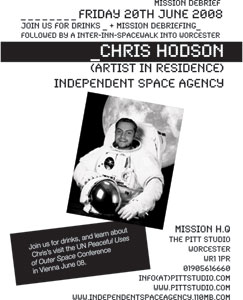
Curator & Artist
Nathaniel Pitt & Christopher Hodson
The Peaceful Uses of Outer Space
UN Assembly, Vienna (2008)
June of 2008. Nathaniel Pitt and Christopher Hodson were successful recipients of the Juliet Gomperts award. Invited as silent observers to the conference entitled The Peaceful Uses of Outer Space, Nathaniel and Chris journeyed to the United Nations in Austria. They established some important multidisciplinary links with space exploration, society and art.
At the time Hodson’s practice was exploring the idea of near and Outer Space as a venue or platform for the creation of artworks, having tentatively established The Independent Space Agency; a very humble one-man attempt at launching ill-fated Space Probes which aimed to place art where no art had gone before.
One of the aims of this project was to place artists in a specialist realm of global politics and science. They met with experts in the field of space exploration. At the meeting in the UN building they attended two days of the conference: The Peaceful Uses of Outer Space, in particular Chris and Nathaniel were interested in the agenda item ‘Space and Society.’ Together they visited, made observations, networked and documented the trip. The artists saw Kofi Annan, Romanian cosmonauts, Western astronauts and even bared witness to the sanctioning and the use of nuclear weapons in space to ‘shepherd’ a possible asteroid in the year 2036.
The organisation of this visit was a exercise in bureaucratic diplomacy. There were several different departmental ‘hoops’ to be navigated and negotiated in the run up to, and during the visit. The artists were assigned a handler; Niklas Hedman, tirelessly Nicklas batted emails back and forth for over two months prior to the visit. Language and identity were two sticking points. As curator, Nathaniel had to supply identity papers in triplicate and convey the reasons for their wish to attend. Art speak clashed with science speak, diplomatic etiquette and form had to be translated and simplified before any agreement could be reached.
As can be imagined, the bureaucracy was not limited to the initial correspondence. Upon arrival both visitor’s Passports were scrutinised by a glum looking security official, copies of which were taken and this was followed by the issuance of Security Passes. A meeting had overrun which meant the contact was running behind schedule, they were asked to pass the time in the United Nations gift shop (yes, such a place exists). Ten minutes later and now loaded up with Novelty UN Flags and Lanyards, an assistant to the Chair of the Committee arrived to usher them through to Conference Room E0970. That was after our Passports had been thoroughly checked for the second time… by the same official.
Once seated on incredibly plush tan leather armchairs at the back of the Conference Room (somewhere between Paraguay and UNESCO), the afternoon’s business commenced. Having hooked on the integral earpiece and cycled through to the English translation, a window onto the starchy and convoluted arena of World Politics and Space Administration was opened.
Before the afternoon’s presentations could begin an hour was spent deliberating over the wording of the previous day’s policy and public relations material. Dotting the Is and crossing the Ts, quite literally - at least fifteen minutes was spent discussing the position of a comma on one particularly dry document. As prudence would have it, “the honourable and most distinguished representatives” justly agreed on it’s position in the text and the document was ratified.